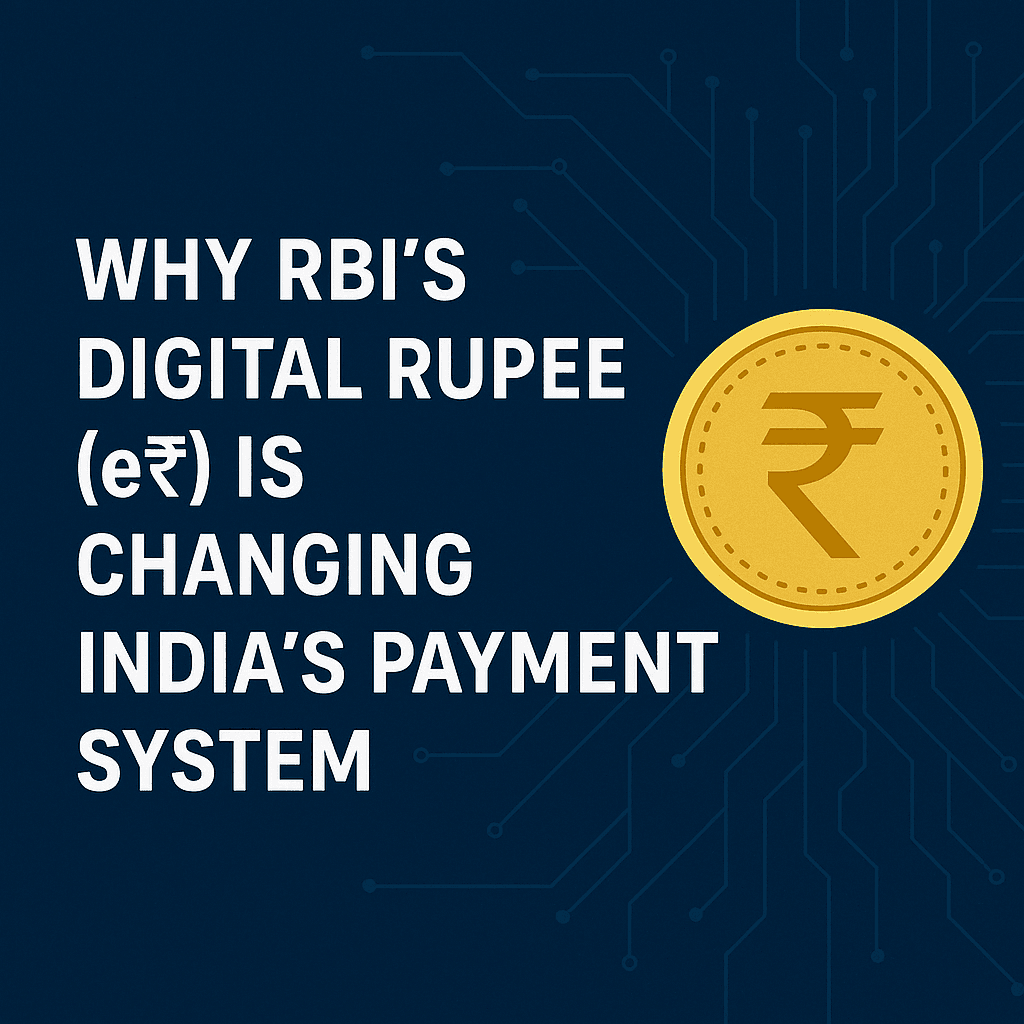India is poised to redefine its financial ecosystem with the advent of the Reserve Bank of India’s (RBI) Digital Rupee (e₹). As the central bank embarks on digitizing the nation’s currency, the new payment system not only promises to enhance transaction security and efficiency but also aims to deepen financial inclusion. This post delves into why the e₹ is set to be a game-changer for India’s payment ecosystem, grounded in current reports, academic research, and expert opinions.
The Digital Rupee (e₹): An Overview
The Digital Rupee represents India’s response to the growing global trend of central bank digital currencies (CBDCs). The RBI’s initiative is designed to augment the existing digital payment infrastructure. It is positioned to serve as a more streamlined, secure, and cost-effective alternative to traditional cash.

Key Features
- Improved Transaction Efficiency: Leveraging distributed ledger technologies, the e₹ can enable near-instantaneous settlement across varied transaction types.
- Enhanced Security: The design incorporates multi-layered security protocols that reduce fraud risks and cyber vulnerabilities.
- Cost Reduction: By cutting down on the costs associated with physical currency management—from printing to transportation. The digital rupee promises long-term economic benefits.
- Financial Inclusion: With a focus on integrating both urban and rural populations, the e₹ can extend financial services to segments of the population that are historically underserved.
These benefits are supported by preliminary findings discussed in academic papers . RBI’s internal assessments, reinforcing the digital rupee’s potential to reshape the payments sector.
Impact on India’s Payment System
Enhanced Transaction Speed and Reduced Friction
Traditional banking and cash transactions often involve time delays and hidden inefficiencies. The introduction of the e₹ aims to simplify these processes. Researchers have highlighted that digital currencies can dramatically reduce settlement times—from hours or days to mere seconds—by eliminating intermediaries in the transaction chain. For instance, the implementation of blockchain-inspired technology is expected to streamline clearing and settlement processes, drawing parallels with international case studies on digital currencies.
Lower Transaction Costs
Current digital payment solutions in India incur various overhead costs, including service fees, ATM costs, and maintenance expenses linked to the physical currency ecosystem. With its reduced reliance on physical infrastructures and centralized processing, the digital rupee could help decrease these expenses. Economic analyses by the Reserve Bank of India suggest that CBDCs have the potential to increase overall economic efficiency by reducing the cost burdens on both the government and private financial institutions.
Financial Inclusion and Digital Ecosystem Expansion
Despite India’s rapid adoption of mobile and internet technology, many segments of the population remain excluded from the formal financial sector. The digital rupee initiative is seen as a catalyst for broader financial inclusion by:
- Simplifying Onboarding: Offering a digital solution that requires less complicated account setups.
- Targeted Outreach: Leveraging government-backed digital identity frameworks (such as Aadhaar) to seamlessly integrate citizens into the digital economy.
- Economic Empowerment: Providing small business owners and rural communities with easier access to secure financial services.
Studies from the International Monetary Fund and World Bank have consistently underscored the transformative potential of digital currencies in emerging economies, echoing the RBI’s commitment to enhancing financial outreach and inclusivity.
Reports and Research: Evidence from the Field
RBI Research Papers and Official Reports
The RBI has released several research documents outlining the strategic benefits of CBDCs and their role in modernizing payment systems. The official reports emphasize:
- Risk Management: Strategies to mitigate cyber risks through robust digital safeguards.
- Monetary Policy Tools: The digital rupee offers a novel channel to conduct monetary policy more effectively, including real-time data collection on economic activities.
- Interoperability: Frameworks are being developed to ensure that the e₹ integrates smoothly with existing payment systems and emerging fintech platforms.
These initiatives are corroborated by real-time assessments from pilot programs and academic studies that detail the operational feasibility of CBDCs in an emerging market like India.
Comparative Analysis with Global CBDC Projects
Several countries, including China with its Digital Yuan and Sweden with its e-krona, are pioneering digital currencies that operate under similar premises. Comparative studies reveal that:
- Operational Efficiency: India’s approach, with its focus on financial inclusion and integrated digital identity systems, presents a unique model.
- Policy Framework: The RBI’s cautious yet progressive policy measures position the e₹ to adapt quickly to evolving digital landscapes and to incorporate feedback from international experiments.
These studies offer valuable insights, demonstrating that India’s transition to a digital currency model is in line with global trends and best practices in central banking.
Challenges and Policy Considerations
Regulatory and Technological Hurdles
While the promise of the digital rupee is significant, the transition is not without challenges:
- Cybersecurity: As with any digital system, ensuring robust cybersecurity measures is paramount.
- Interoperability with Legacy Systems: Bridging the gap between newer digital systems and the existing traditional banking infrastructure requires continuous innovation.
- Public Adoption: Educating the public on the benefits and usage of a CBDC remains a critical part of the strategy. Initiatives by the RBI, including public awareness campaigns, are designed to address these concerns.
Policy Measures and Future Roadmaps
The RBI is actively engaging in discussions and collaborations with international financial institutions and domestic stakeholders to refine the digital currency framework. Policy revisions and pilot testing are ongoing, designed to iron out potential issues before a nationwide rollout. These efforts are paralleled by academic research that models the potential impact on national monetary policy and economic stability.
The policies are made on basis of global news too so to get stay updated click here
Conclusion
The advent of RBI’s Digital Rupee is not just a technological upgrade—it represents a paradigm shift in India’s payment ecosystem. With faster transactions, reduced costs, and a push towards comprehensive financial inclusion, the e₹ is set to modernize the country’s economic landscape. However, as with any transformative innovation, it comes with its array of challenges that require careful regulatory oversight and robust technological investments.
As India continues to embark on this digital journey, the lessons from global CBDC projects and in-depth RBI research provide a promising roadmap for future success. For policymakers, businesses, and citizens alike, staying informed about these changes is crucial as we collectively navigate the evolving world of digital finance.
References
- Reserve Bank of India. (2023). CBDC Research and Policy Papers. Available at the official RBI website.
- International Monetary Fund. (2022). Digital Currencies in Emerging Economies. Retrieved from IMF Publications.
- World Bank. (2022). The Role of Digital Currencies in Financial Inclusion. Accessible through the World Bank online repository.
- Economic Times Reports on Digital Rupee developments. (2023). Digital Rupee: Efficiency and Financial Inclusion in India. Available on the Economic Times website.
(Please ensure that you verify and update the reference links and publication years as per your latest research and sources.)




